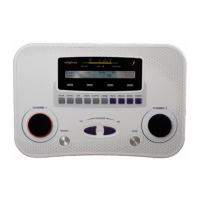53
D-0126050 rev 1 - 270+ Operating Manual
8.5. FREEFIELD SPEECH CALIBRATION
8.5.1. GENERAL
The freefield speech calibration is carried out in two stages:
1. The speech channel, which contains two elements:
o an optional equalisation phase
o a level-setting phase
2. The competing noise channel, which may be omitted if competing noise is not required
8.5.2. CALIBRATING THE SPEECH CHANNEL: EQUALISATION (OPTIONAL)
Follow the steps described below to perform equalisation:
1. Connect an external speech source (e.g. CD or tape/MP3 player) to the audiometer.
2. Switch the device on and enter the SPEECH module.
3. Select the FREEFIELD option via the OUTPUT button.
4. Use softkey F2 to select LINE as input signal.
5. When more than one loudspeaker is used, select the correct loudspeaker by choosing LEFT or
RIGHT, pressing softkey F4.
6. After the selection is done, play the test signal from the speech recording, which should either be:
• pink noise used with a third-octave spectrum analyser and the SLM
• third-octave noise bands used with the SLM
7. Use the Channel 1 rotary control set the output to 70dBHL and adjust the external amplifier to give a
reading of 90dBSPL as measured by the SLM at the reference point.
The response should then be checked to be within the following limits (IEC 60645-2:1993 Section
10.1):
If necessary, adjustments should be made using the amplifier controls or an additional graphic equaliser to
achieve this response.
As an alternative to using an external speech source, the warble-tone calibration method and controls may be
used to achieve this response. Note that this will invalidate any previous freefield warble tone calibration, and
this must be repeated when warble tone testing is required.
8.5.3. LEVEL SETTING
The calibration tone from the speech recording should be played and the external amplifier volume control
used to give a reading of 90dBSPL for a 70dBHL instrument setting. Once set, no further adjustment should
be made to the external amplifier or graphic equaliser controls (if used for equalisation).
If more than one set of test recordings is to be used then the following procedure can be used to allow for
minor differences in calibration levels:
• Set up as above for the most commonly used test recording

